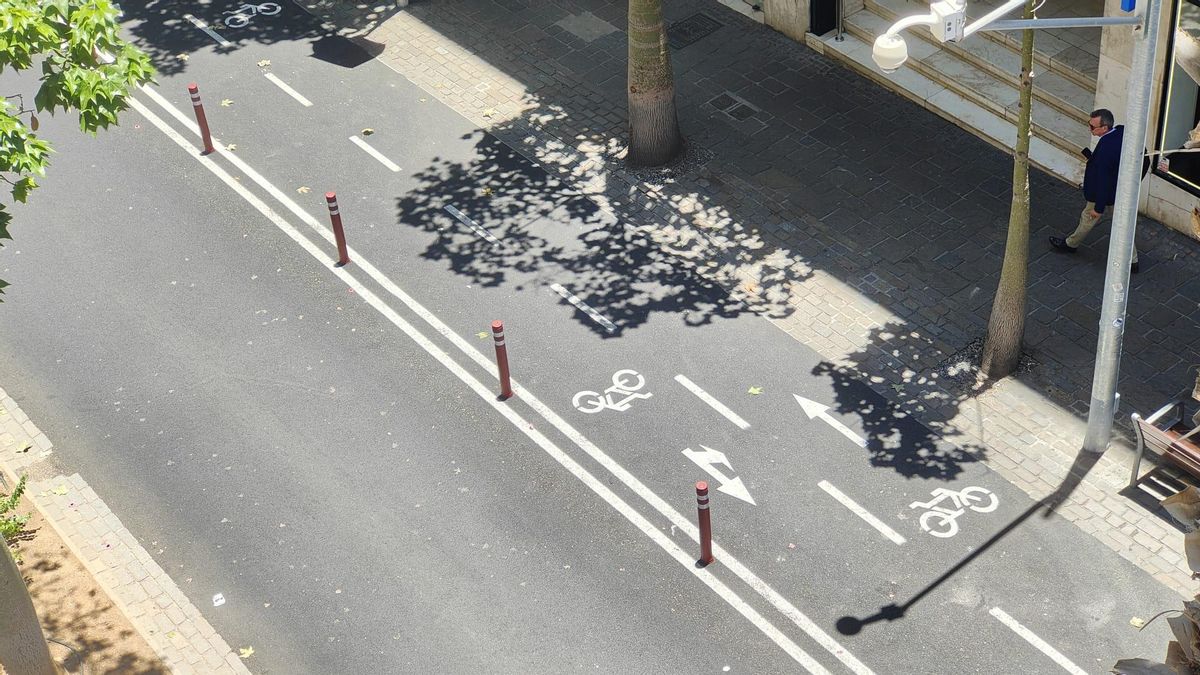The cycle lane in Santa Cruz de Tenerife, which theoretically aims to facilitate sustainable mobility in the city centre, started off on the wrong foot. From the very first day the City Council workers began putting up traffic signs indicating the start of construction, the first protests began. Complaints arose because not only were hundreds of public parking spaces removed in a key area for businesses and densely populated buildings mostly lacking garages, but also loading and unloading zones around the pedestrian area of the centre, taxi ranks, stopping points and even a traffic lane in important streets like calle del Pilar and Méndez Núñez were affected.
Soon after the outline of the lane started to appear on the roads, the protests intensified, including the organisation of three demonstrations and a taxi drivers protest demanding its removal. They claimed it caused problems for around 10,000 residents, along with business owners, workers, and visitors to the centre. However, the crucial battle hasn’t taken place in the streets but in the courts, where a ruling and a court order have so far thwarted the City Council’s aspirations, under the governance of the Canary Coalition and the Popular Party, to carry out this project, funded by European funds and supported by the Councillor for Mobility, Evelyn Alonso (an expelled Citizens member), and the Councillor for Public Services, Carlos Tarife (PP).
The first and most significant setback occurred last March when a ruling by the Superior Court of Justice of the Canary Islands (TSJC) declared the entire Mobility and Road Safety Ordinance, approved by the City Council led by José Manuel Bermúdez (Canary Coalition), in January 2024, null and void. The reason: the ordinance did not comply with the law. The judgment stated unequivocally: “It must be considered to all intents and purposes as if it never existed, it was never valid or effective, as it could not be born into legal life, having been merely an appearance of legality now definitively removed by this judgment.”
The ruling explained that “the cause of absolute nullity, affecting the entire Ordinance, was the absence of a regulatory impact analysis report, as the existing one in the administrative record cannot be counted as such, but only in name.” This report presented by the City Council consisted of 38 pages, but according to the TSJC none of them were dedicated to a detailed analysis of the Ordinance, article by article. “The terms of the supposed report are so generic that it could apply to any mobility ordinance one wanted to adopt,” the TSJC considered.
Moreover, it added: it is a “mere proclamation of generalities without analysing the specific ordinance the report should refer to.” Several articles of the ordinance lacked detailed reasoning for why the agreed measure was essential to achieve the regulation’s purpose and couldn’t be achieved with a less invasive measure on citizens’ freedoms. “And there’s a long etcetera,” the ruling stated. Therefore, it concluded that the alleged report was not in reality, invalidating the supposed ordinance completely.
This ruling responded to a contentious-administrative appeal filed by the El Perenquén Urban Zone Neighbourhood Association, which opened the way to halt the municipal regulation encompassing the controversial cycle lane, already costing 1.3 million euros of public money plus the legal fees of the first process.
That same month, a demonstration in favour of the cycle lane took place, attended by several members of the corporation, including the Mobility Councillor herself.
Now, two months later, the TSJC’s Contentious-Administrative Chamber has issued an order directing the City Council not to continue with the cycle lane works. It was scheduled to be fully operational by the end of this month and is already fully installed on the streets, waiting only for a few details. It already has painted signs on the ground, vertical signs, special traffic lights, and barriers to demarcate it in the form of metal bollards placed on the road, preventing vehicles from entering the said lane.
This order also responds to an appeal by the same residents association, El Perenquén, who demanded last April the total dismantling of the cycle lane and urban zone, arguing that after nullifying the Mobility and Road Safety Ordinance, which was meant to regulate the low emission zone in the capital, there is no longer a legal basis for its development.
Despite April’s ruling, the council continued the works normally and announced, following complaints from business owners, that loading and unloading zones had been expanded. Now they are further from the main roads, once again eliminating previously free street parking zones.

The City Council announces it will appeal
This Tuesday the City Council responded by holding a press conference announcing the immediate halt to the cycle lane works, but also stating they will appeal the order (they have five days to do so).
Carlos Tarife himself appeared to explain that the pending works have been stopped, but he noted that these are “almost none” as the works were nearly completed.
Tarife stated that the City Council, which received the order on Tuesday, understands that the mobility ordinance is not annulled, as the Supreme Court is yet to decide whether it accepts the corporation’s appeal against the Canarian court’s decision.
However, he specified that if annulled, the previous regulation, dating back to 1985, allows the City Council to implement segregations on public roads precisely to allow safer circulation for different vehicles than the ordinary ones.
That will, therefore, be the City Council’s line of defence for maintaining this work, which faces rejection from numerous sectors of the capital’s population.
“I want to live in a better and friendlier Santa Cruz,” the councillor continued, defending the work, without addressing the lack of parking it generates, the traffic disruptions leading to previously non-existent traffic jams due to the lack of space for rubbish trucks to operate, taxis to stop without disrupting traffic, or cars to pull over in case an emergency vehicle arrives.
A city with few cyclists
Protest organisers against the cycle lane have emphasised in all demonstrations that they are not against sustainable mobility, but in how the Santa Cruz de Tenerife City Council has implemented it, without consulting citizens, causing numerous problems for residents and business owners in the centre without offering realistic alternatives, as a large part of the population cannot use bicycles or scooters. In fact, the banners used in the protests highlighted the phrase “Not like this”.
Silvia Barrera, president of the association that currently counts two wins against the City Council, believes that more than bicycles, electric scooters are being prioritised, particularly for tourists visiting the city for agile movement. In statements to this newspaper, Barrera warned of the consequences for “the elderly, many of them residents in these areas, pregnant women, people with mobility issues or simple pedestrians who do not use bikes or skates; even more so, those who are terrified due to recent incidents, accidents or the speed at which some take.”
The organisations behind the protests have repeatedly reminded that the council is responsible for the loss of over 5,000 parking spaces in recent years in Santa Cruz and that a cycling network is not among the primary demands of the city’s inhabitants, filled with hills, crossed by a ravine and with narrow streets.
The cycle lane has been a topic of conversation for months not only among the residents of the centre but also among many from La Laguna, who think twice before coming down to the capital. It’s not only the scarcity of free parking now; it’s also that reaching the commercial area now means facing traffic jams where there were none before.
















